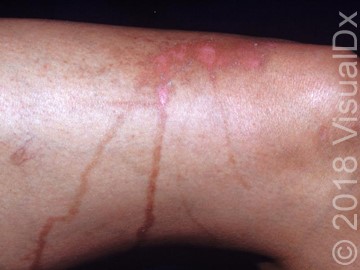Published on

Differential Diagnosis
- Irritant contact dermatitis
- Erythema multiforme
- Phytophotodermatitis
- Fixed drug eruption
Diagnosis
This patient was diagnosed with phytophotodermatitis, a cutaneous phototoxic eruption caused by the interaction of furocoumarins found in some common plants with solar UVA radiation. It is a common skin complaint in travelers to tropical regions.
Learnings/What to Look for
- Approximately 24 hours after plant contact with subsequent exposure to sunlight, a burning erythema develops. Limes, other citrus fruits, celery, figs, meadow grass, certain weeds, and oil of bergamot are frequently causative. In this patient’s case, it was likely slicing and squeezing limes, lemons, and oranges for cocktails
- Exposure to the plant sap of wild parsnip (Pastinaca sativa; “poison parsnip”), common throughout the United States, can cause severe phytophotodermatitis
- There is no predilection for any age or ethnicity or either sex, although phytophotodermatitis may be more noticeable in lighter skin phototypes
Pearls for Urgent Care Management and Considerations for Transfer
- Phytophotodermatitis is benign and self-limited. Treatment is supportive
Acknowledgment: Image and case courtesy of VisualDx (www.VisualDx.com/JUCM).
A 24-Year-Old Female with a New, Unexplained ‘Rash’ on Her Leg
1 2
